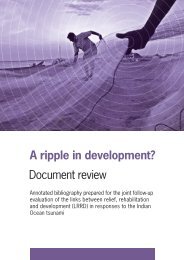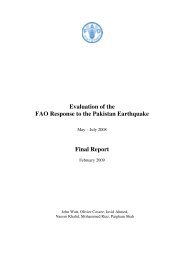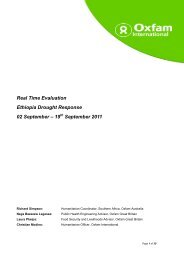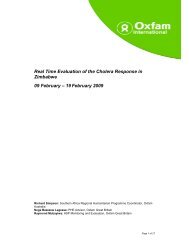Inter-Agency Real Time Evaluation of the Humanitarian ... - alnap
Inter-Agency Real Time Evaluation of the Humanitarian ... - alnap
Inter-Agency Real Time Evaluation of the Humanitarian ... - alnap
Create successful ePaper yourself
Turn your PDF publications into a flip-book with our unique Google optimized e-Paper software.
IA RTE <strong>of</strong> <strong>the</strong> humanitarian response to Pakistan’s 2010 Floods crisis<br />
94. NDMA and Line Departments, with cluster leads, define minimum assistance standards<br />
for disaster response in Pakistan (considering type <strong>of</strong> disaster, scale and length, as well as pre‐<br />
existing capacities and vulnerabilities. HC/RC, with OCHA, will ensure HCT alignment on<br />
guidelines for use <strong>of</strong> military assets in future emergencies (only as providers <strong>of</strong> last resort).<br />
95. The international humanitarian system should implement geographic area based<br />
responses in future disasters <strong>of</strong> similar scale<br />
6.5 Connectedness<br />
Response focus, <strong>the</strong> missing link <strong>of</strong> recovery<br />
96. Most <strong>of</strong> <strong>the</strong> international response focused on relief ra<strong>the</strong>r than on recovery activities,<br />
with few resources allocated to fund <strong>the</strong> PFRERRP’s more than 252 early recovery projects. As<br />
focus is now gradually shifting to recovery, agencies find <strong>the</strong>mselves with few resources to<br />
provide assistance to meet expected recovery needs, hampering current efforts to bring people<br />
back on <strong>the</strong>ir feet. Fur<strong>the</strong>rmore, <strong>the</strong>se efforts are coming too late for most <strong>of</strong> <strong>the</strong> affected<br />
population as most <strong>of</strong> <strong>the</strong> affectees returned to <strong>the</strong>ir places <strong>of</strong> origin as early as September and<br />
October last year.<br />
97. NDMA currently have already defined early recovery strategies for 7 sectors None<strong>the</strong>less,<br />
with a few exceptions, <strong>the</strong>y seem to be detached from cluster efforts. Generally, recovery has<br />
not been carefully planned for by most clusters, with exception <strong>of</strong> logistics and nutrition;<br />
logistics have a clear transition strategy, while <strong>the</strong>re is progress on a similar nutrition 18‐month<br />
transition strategy. The challenge facing <strong>the</strong> shelter strategy’s one‐house policy is <strong>the</strong> inability <strong>of</strong><br />
actors and government to effectively act upon it due to limited financial resources. The result is<br />
that only very limited numbers <strong>of</strong> one‐room shelters have been build (see fur<strong>the</strong>r below). To<br />
date, recovery activities carried out has essentially been on individual agency level with fewer<br />
cluster perspectives. The isolated efforts are at <strong>the</strong> clear expense <strong>of</strong> more integrated<br />
approaches.<br />
Economic and livelihood recovery constraints:<br />
98. During <strong>the</strong> emergency response, WATAN cards distribution was instrumental in<br />
reactivating local markets. Also <strong>the</strong> Benazir Income Support Programme (BISP) rapidly supported<br />
affected population with small cash grants <strong>of</strong> Rs 4,000 only weeks after <strong>the</strong> floods. According to<br />
data from National Database & Registration Authority (NADRA) as <strong>of</strong> January 30, 1.48 million<br />
WATAN cards have been distributed, representing a total value <strong>of</strong> approximately Rs. 27.5<br />
Riccardo Polastro, Aatika Nagrah, Nicolai Steen and Farwa Zafar<br />
42
















